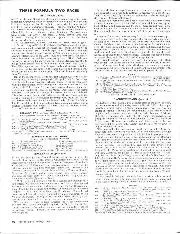
Three Formula Two Races
Rouen (July 9th) Most of the star Grand Prix drivers were taking part in this race, except for Gurney who does not approve of top league drivers playing in a lesser league,…
Honda set out on a mission in the mid-1980s. The Japanese manufacturer wanted to build a sports car that was every bit as good as the equivalent Ferrari of the time. Anyone who has driven the original NSX will attest that it was more than a match for what the Italian marque had to offer when it went on sale in 1990.
The Ferrari 348 launched a year before the Honda might have edged it on numbers, but the NSX offered the more sublime driving experience. It was more usable around town, quicker on country roads, superior in build and more reliable. For many its understated Pininfarina lines made it better looking, too.
The NSX had an unusually long gestation period as Honda strove for perfection at a time when the Japanese economy was booming. The first concept of the NSX had been shown as early as 1984. The HP-X — Honda Pininfarina Experimental — was unveiled at the 1984 Turin Motor Show with a version of the V6 engine that had powered Geoff Lees and Jonathan Palmer to European F2 glory in 1981 and ’83 with the Ralt team, and was in the process of doing the same with Mike Thackwell that year.
The HP-X was a real, running prototype. Access to the car was through a giant tilting cockpit inspired by a jet fighter. The cab-forward layout design with driver visibility in mind made it all the way through to the finished article unveiled in early 1989 as the NS-X. The hyphen had been quietly dropped by the time it went on sale the following year.

Honda’s aim was to build a lightweight machine: the NSX was the all-aluminium production car ever built. At its centre was an extruded aluminium alloy semi-monocoque chassis with just one steel component. The suspension was aluminium, too, in the name of reducing unsprung weight. The total weight-saving over steel construction was said to be 200kg.
The aluminium 3-litre V6 power unit, mounted crossways behind the driver, employed the variable valve-timing VTEC system that had come to market in ’89 on the Integra saloon. That, and the titanium conrods, allowed the NSX to rev higher than its rivals, and to be more docile lower down the rev range.
“The problem was image for a brand that built tin-box Civics and mopeds”
Honda didn’t rest on its laurels. A Type R version came on stream in 1992, and then another performance upgrade in 1997 with the arrival of a 3.2-litre engine with nearly 20 more horsepower and a six-speed gearbox. Even more extreme versions the Type S and S-Zero followed before the original car, the NA1, received a facelift with the arrival of the NA2 in 2002.
For all Honda’s success in F1 through the ’80s and into the ’90s — that’s five drivers’ and constructors’ titles and 69 grand prix wins — the marque failed to convince the wider world that the NSX had the pedigree of a Ferrari or a Porsche, even if more than 18,000 NA1s had been sold before production ceased in 2005.
There was a short-lived, half-hearted and largely unsuccessful attempt to imbue the NSX with some racing heritage at the Le Mans 24 Hours starting in 1994. A privateer entrant claimed a class win in 1995 with a GT2 car developed in the UK by TC Prototypes, but a move to GT1 by the factory team in search of outright glory that same season was an abject failure.
The problem for a manufacturer whose core business was building tin-box Civics and mopeds was one of image. The NSX was a Ferrari-beater with the wrong badge.

HONDA NSX
• Price new £55,000
• Price now £30,000-45,000
• Engine 3.0-litre normally aspirated V6
• Power 274bhp
• 0-60mph 5.9sec
• Top speed 167mph
• Rivals Ferrari 348, Porsche 911 Carrera 2
• Verdict Reliable and usable supercar that could more than hold its own with the opposition of the day
30 years in the making: the legend of the NSX
I don’t think anyone could have imagined just how big an impact the original Honda NSX would have had in the 30 years since its first appearance at the Chicago Auto Show in 1989.
From a buyer’s perspective NSX prices are not yet out of reach but finding the right example can take time and values quickly climb.
It’s estimated that there are approximately 250 cars in the UK, although vehicles imported from Japan and left-hand drives are not uncommon. There are more manual versions on the road, but they are rarer on the used market. Neglected cars are uncommon, but the cheapest may be lacking a full-service history, so spend time checking paperwork.
Prices for an early automatic example generally start around £35,000, while cleaner examples with low miles, and those from independent dealers, add roughly £10,000 more.
Honda NSXs at auction will be the cleanest examples with low mileage. As a result, expect to pay from £47,000 upwards for a 1991 car, with the best approaching £60,000. For the rarest of the rare, the NSX R is the model of choice, and you can pay more than £150,000 for a 1995 example and around £250,000 for a facelifted model from 2005.
Robert Johnson, Classic and Sports Finance
